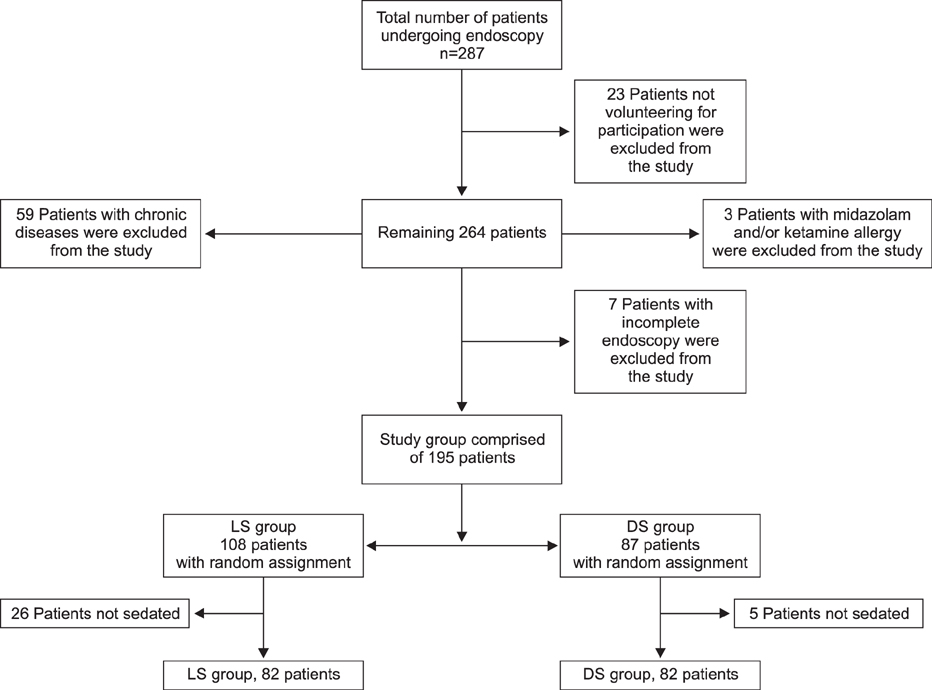Pediatr Gastroenterol Hepatol Nutr.
2017 Jun;20(2):87-93. 10.5223/pghn.2017.20.2.87.
Investigation of Efficacy of Lidocaine Spray for Sedated Esophagogastroduodenoscopy in Children
- Affiliations
-
- 1Department of Pediatric Gastroenterology, Faculty of Medicine, Akdeniz University, Antalya, Turkey. drahmetbasturk@hotmail.com
- KMID: 2384821
- DOI: http://doi.org/10.5223/pghn.2017.20.2.87
Abstract
- PURPOSE
Our aim in this study is to investigate efficacy of topical lidocaine spray for sedated esophagogastroduodenoscopy (EGD) in children.
METHODS
The endoscopy of children aged between 3-18 years who underwent EGD in our endoscopy unit. Intravenous (IV) midazolam and ketamine were used for sedation. Prior to sedation, endoscopy nurse applied topical lidocaine 10% with pump spray at 1 mg/kg dose in group 1, and distilled water via identically scaled pump spray in group 2, in a double blinded fashion.
RESULTS
Sedation was not applied in 24.1% of the cases in topical lidocaine spray group (LS group) and in 5.7% of the cases in distilled water spray group (DS group). Gag reflex was observed in 6.5% of cases in LS group and 33.3% of cases in DS group (p=0.024), increased oral secretion was observed in 9.3% of cases in LS group and 51.7% of cases in DS group (p=0.038), sore throat was observed in 3.7% of cases in LS group and 35.6% of cases in DS group (p=0.019) and the difference was statistically significant.
CONCLUSION
The study showed that topical pharyngeal lidocaine reduces both requirement and amount of IV sedation before EGD in children and sore throat, gag reflex and decreased oral secretion increase.
MeSH Terms
Figure
Reference
-
1. Clarke GA, Jacobson BC, Hammett RJ, Carr-Locke DL. The indications, utilization and safety of gastrointestinal endoscopy in an extremely elderly patient cohort. Endoscopy. 2001; 33:580–584.
Article2. Van Kouwen MC, Drenth JP, Verhoeven HM, Bos LP, Engels LG. Upper gastrointestinal endoscopy in patients aged 85 years or more. Results of a feasibility study in a district general hospital. Arch Gerontol Geriatr. 2003; 37:45–50.
Article3. al-Atrakchi HA. Upper gastrointestinal endoscopy without sedation: a prospective study of 2000 examinations. Gastrointest Endosc. 1989; 35:79–81.
Article4. Keeffe EB, O'Connor KW. 1989 A/S/G/E survey of endoscopic sedation and monitoring practices. Gastrointest Endosc. 1990; 36:3 Suppl. S13–S18.5. Davis DE, Jones MP, Kubik CM. Topical pharyngeal anesthesia does not improve upper gastrointestinal endoscopy in conscious sedated patients. Am J Gastroenterol. 1999; 94:1853–1856.
Article6. Hedenbro JL, Ekelund M, Jansson O, Lindblom A. A randomized, double-blind, placebo-controlled study to evaluate topical anaesthesia of the pharynx in upper gastrointestinal endoscopy. Endoscopy. 1992; 24:585–587.
Article7. Evans LT, Saberi S, Kim HM, Elta GH, Schoenfeld P. Pharyngeal anesthesia during sedated EGDs: is "the spray" beneficial? A meta-analysis and systematic review. Gastrointest Endosc. 2006; 63:761–766.
Article8. Gordon MJ, Mayes GR, Meyer GW. Topical lidocaine in preendoscopic medication. Gastroenterology. 1976; 71:564–569.
Article9. Lowrie L, Weiss AH, Lacombe C. The pediatric sedation unit: a mechanism for pediatric sedation. Pediatrics. 1998; 102:E30.
Article10. Martinez JL, Sutters KA, Waite S, Davis J, Medina E, Montano N, et al. A comparison of oral diazepam versus midazolam, administered with intravenous meperidine, as premedication to sedation for pediatric endoscopy. J Pediatr Gastroenterol Nutr. 2002; 35:51–58.
Article11. Green SM, Li J. Ketamine in adults: what emergency physicians need to know about patient selection and emergence reactions. Acad Emerg Med. 2000; 7:278–281.
Article12. Tolia V, Peters JM, Gilger MA. Sedation for pediatric endoscopic procedures. J Pediatr Gastroenterol Nutr. 2000; 30:477–485.
Article13. Quine MA, Bell GD, McCloy RF, Charlton JE, Devlin HB, Hopkins A. Prospective audit of upper gastrointestinal endoscopy in two regions of England: safety, staffing, and sedation methods. Gut. 1995; 36:462–467.
Article14. Soweid AM, Yaghi SR, Jamali FR, Kobeissy AA, Mallat ME, Hussein R, et al. Posterior lingual lidocaine: a novel method to improve tolerance in upper gastrointestinal endoscopy. World J Gastroenterol. 2011; 17:5191–5196.
Article15. Ayoub C, Skoury A, Abdul-Baki H, Nasr V, Soweid A. Lidocaine lollipop as single-agent anesthesia in upper GI endoscopy. Gastrointest Endosc. 2007; 66:786–793.
Article16. Salale N, Treldal C, Mogensen S, Rasmussen M, Petersen J, Andersen O, et al. Bupivacaine lozenge compared with lidocaine spray as topical pharyngeal anesthetic before unsedated upper gastrointestinal endoscopy: a randomized, controlled trial. Clin Med Insights Gastroenterol. 2014; 7:55–59.
Article17. Chan CK, Fok KL, Poon CM. Flavored anesthetic lozenge versus Xylocaine spray used as topical pharyngeal anesthesia for unsedated esophagogastroduodenoscopy: a randomized placebo-controlled trial. Surg Endosc. 2010; 24:897–901.
Article18. İbiş M, Arhan M, İbiş T, Önal İK, Erdal H, Utku ÖG. Lidocaine versus lidocaine plus benzydamine as a topical anesthesia regimen for unsedated upper gastrointestinal endoscopy: a comparison study. Turk J Gastroenterol. 2015; 26:224–227.
Article19. Motamed F, Aminpour Y, Hashemian H, Soltani AE, Najafi M, Farahmand F. Midazolam-ketamine combination for moderate sedation in upper GI endoscopy. J Pediatr Gastroenterol Nutr. 2012; 54:422–426.
Article20. Brecelj J, Trop TK, Orel R. Ketamine with and without midazolam for gastrointestinal endoscopies in children. J Pediatr Gastroenterol Nutr. 2012; 54:748–752.
Article21. Langston WT, Wathen JE, Roback MG, Bajaj L. Effect of ondansetron on the incidence of vomiting associated with ketamine sedation in children: a double-blind, randomized, placebo-controlled trial. Ann Emerg Med. 2008; 52:30–34.
Article22. Green SM, Klooster M, Harris T, Lynch EL, Rothrock SG. Ketamine sedation for pediatric gastroenterology procedures. J Pediatr Gastroenterol Nutr. 2001; 32:26–33.
Article23. Wathen JE, Roback MG, Mackenzie T, Bothner JP. Does midazolam alter the clinical effects of intravenous ketamine sedation in children? A double-blind, randomized, controlled, emergency department trial. Ann Emerg Med. 2000; 36:579–588.
Article
- Full Text Links
- Actions
-
Cited
- CITED
-
- Close
- Share
- Similar articles
-
- The Effect of Lidocaine Spray before Endotracheal Intubation on the Incidence of Cough and Hemodynamics during Emergence in Children
- The Effect of 10 % Lidocaine Spray on Hemodynamics and Postoperative Sore Throat Accompanied by Endotracheal Intubation
- Difference between Cardiovascular Response Blockades by Orolaryngeal and Nasal Lidocaine Sprays during Nasotracheal Intubation under Direct Laryngoscopy
- Plasma Lidocaine Concentration and Hemodynamic Effect after 10% Lidocaine Spray on Laryngopharyngeal and Intratracheal Site during the Endotracheal Intubation
- Effects of 10% lidocaine spray on arterial pressure increase due to suspension laryngoscopy and cough during extubation



